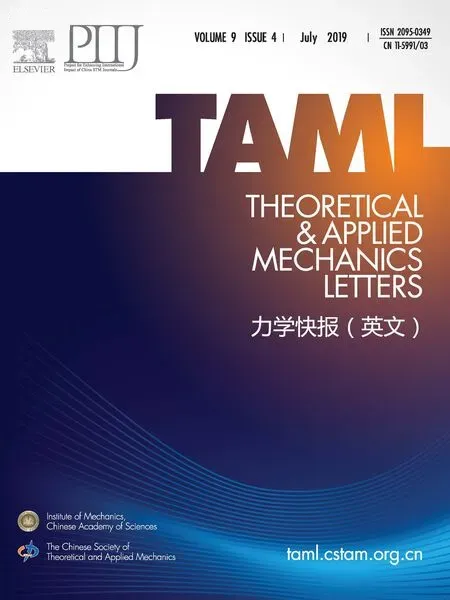Response to (Comment on the paper "Theoretical & Applied Mechanics Letters 7 (2017) 235-242”)
2019-08-17YhyShgiyDnielZinlAdulAzizZuhilIsmilFislSlh
Yhy Shgiy Dniel, Zinl Adul Aziz,*, Zuhil Ismil, Fisl Slh
a UTM Centre for Industrial and Applied Mathematics, Universiti Teknologi Malaysia, Johor, Malaysia b Department of Mathematics, Faculty of Science, University of Kordofan, Elobid 51111, Sudan
Equation (1) in Ref. [1] with parameter RD is the standard governing equation for entropy generation of nanofluid flow over a stretching sheet via Buongiorno's model. Reference to countless published papers, as few are listed below [2-11] for details.
RD is absent from the dimensional Eqs. (1)-(6) in Ref. [1],which we included in Ref. [1] as reference to the study of the related flow behaviors of the nanofluid. These equations constitute the governing flow equations of nanofluid over a stretching sheet in Ref. [1], and these dimensional equations are independent from the entropy generation Eq. (1) from Ref. [1] with RD as mentioned above. Entropy generation measures the degree or level of available (existing) irreversibilities within a process. The entropy generation equation is an extension from the governing flow Eqs. (1)-(6).
The transformed Eqs. (18)-(21) in Ref. [1] are dimensionless form of constitutive governing Eqs. (1)-(6) in Ref. [1]. In order to determine the entropy generation in a flow when heat and mass are being transferred simultaneously, the velocity, temperature,and concentration fields must be known, and thus initially, these are expressed in the transformed Eqs. (18)-(21) in Ref. [1]without RD (also for other related problems, see Refs. [2-11]).Our nanofluid model is via the Buongiorno mathematical model. Brownian motion and thermophoresis effects on entropy generation and Bejan number have been examined. Total entropy generation is inspected through various flow variables. Since the flow in Ref. [1] is laminar, the velocity, temperature and concentration fields are well known and can be directly used to evaluate the entropy generation in Eq. (25) in Ref. [1] with RD, which is the standard and widely used equation in works by many different researchers, for Buongiorno nanofluid flow model.
It is not a serious problem. Rd is different from RD in Ref. [1].RD is absent from the Nomenclature, and as mentioned, RD refers to the following: R = ideal gas constant and D = molecular diffusion coefficient (the mass diffusivity).
See Refs. [2] and [3], as defined in their Nomenclature.Among numerous published research works, see below from Refs. [4-11], it is normal not to mention RD in the Nomenclature。
It is not irrational, as discussed above, Eqs. (1)-(24) which refer to the flow characteristics are the constituted governing equations with transformed equations without RD. Equation(25) in Ref. [1] is an extension and refer to the standard entropy generation equation with RD relating to Buongiorno mathematical nanofluid model. Brownian motion and thermophoresis impacts on entropy generation Eq. (25) and Bejan number Eq. (27)have been examined in Ref. [1]. See Refs. [2-11] for more details.
The constituted governing flow with transformed Eqs.(1)-(24) in Ref. [1] are used to examine the flow behaviors.Whiles physically, the entropy generation Eq. (25) in Ref. [1]refers to the amount or sum of the irreversibilities with the thermal gradients, the viscous dissipation, the concentration gradients and the Ohmic heating.
Among the countless published research works with the same approach, please refer to the few listed research works[2-11] for further clarifications.
We acknowledged that there was a typographical error made only in Eq. (25) in Ref. [1]. Instead of writing, we mistakenly wrotein the second term as pointed. Nonetheless, these are correctly reflected in the following subsequent Eqs. (26) and (27)in Ref. [1]. The typographical error had not in any way affected the emerging parameters and findings, as discussed and ex-amined, see Ref. [1]. It should be written as
These quantities are now of the same units (i.e. RD (m-2))and addition is allowed, see also Refs. [2-11].
Again we would like to emphasize that this has not in any way affects our dimensionless entropy generation and Bejan number Eqs. (26) and (27) respectively in Ref. [1] and the research findings.
In heat and mass transfer, Grashof number approximates the ratio of the buoyancy to viscous force acting on a fluid. In our work which is heat and mass transfer, the definition goes with the Buongiorno mathematical nanofluid model.
We admitted that there was a typographical error in expressing the Gr parameter, i.e., there should include x3. Grashof number is an emerging parameter, and as defined earlier, this still held as discussed in Ref. [1]. It should be written as

Thus Gr is a dimensionless number and this typographical error does not in any way affects the subsequent dimensionless Eqs. (18)-(21) in Ref. [1].
After our extensive and very careful reexamination of Ref. [1],we are certain that our research findings prevailed as published and recorded in Ref. [1].
For your information, many researchers have used this Gr parameter for different models and expressed it based on theirs problems, please refer to the following works for details [12-21].
Other than these two typographical errors, which have no effects on others emerging parameters, dimensionless forms, results and discussion in Ref. [1], we are convinced that the article is alright.
杂志排行
Theoretical & Applied Mechanics Letters的其它文章
- Comment on the paper “Theoretical & Applied Mechanics Letters 7 (2017)235-242”
- Analytical modeling for rapid design of bistable buckled beams
- Comparative numerical study on the child head injury under different child safety seat angles
- Direct method for a Cauchy problem with application to a Tokamak
- Thermal explosion and irreversibility of hydromagnetic reactive couple stress fluid with viscous dissipation and Navier slips
- On the Weissenberg effect of turbulence
